How to Fix ‘Error Occurred while Installing the Selected Updates” on macOS
The Error ‘An error occurred while downloading the updates (Update Failed)‘ prompt when attempting to install a newer version of macOS. This problem is typically reported to occur when the user attempts to install the Catalina and Big Sur versions of macOS.
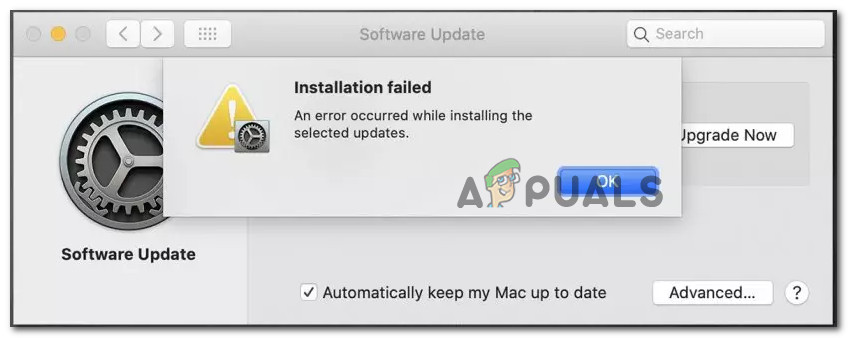
After investigating various user reports and attempting to replicate the issue on our machines, it turns out that there are several different underlying causes that might lead to the apparition of this error code. Here’s a shortlist of potential culprits that might be responsible for this error code:
- Apple Server issue – As it turns out, you can expect to face this issue if Apple is currently dealing with an issue in regards to the Software Update delivery infrastructure. If this scenario is applicable, the only thing you can do is identify the server issue and wait for Apple to fix the issue on their side.
- Network inconsistency – A network glitch can also interfere with your attempts at installing the latest system update for your macOS computer. If the problem is related to an IP or TCP data inconsistency, you should be able to get the issue resolved by restarting or resetting your router.
- A Conflict caused by 3rd party kernel extension software – According to a lot of affected users, there are several 3rd party tools that might cause this error due to the fact that they interact with the kernel. To avoid this particular issue, you’ll need to uninstall kernel extension software like Parallels, CPU Gadget, or Little Snitch before attempting to install the pending update once again.
- An issue with PRAM or NVRAM caches – Another scenario that might prevent your system from installing a pending system update is an issue with the NVRAM or PRAM caches. Several users dealing with the same problem have reported that they finally managed to get the issue fixed after resetting both of these caches.
- Corrupted iTunes entry in the /hosts file – As it turns out, there are certain situations where your /etc/hosts file might become unusable due to a corrupted iTunes entry and interfere with the installation of a pending system update. If this scenario is applicable, you should be able to fix the issue by removing the problematic iTunes entry from the hosts file manually.
- Corrupted OS-related temporary files – Corrupted remnants from a previous attempt at installing the system OS version might interfere with any new attempts at making the leap to Big Sur. In this case, you’ll need to start by cleaning the caches folder before retrying the update.
- Corrupted Software Update Catalog – MacOS Catalina and older versions might suffer from a glitch that affects the Software Update Catalog and ‘convinces’ your system that it doesn’t actually need the pending update. In this case, you will need to clear the software update catalog first before attempting to install the pending update once again.
Now that you are familiar with every potential reason that might cause the error occurred while downloading the updates message pop-up when you attempt to update your macOS to the latest version available, let’s take a look at a couple of fixes that other dealing with the same issue have successfully used:
Check for a Server Issue
Before you go ahead and follow the other methods below to troubleshoot a local issue that’s causing the update failed error, you should start by ensuring that Apple is not currently experiencing issues with their Software Update delivery function.
In the past (when the Big Sur update was officially released), there was a surge of “An error occurred while downloading the updates (Update Failed)” reports as the Software Update component of Apple effectively broke.
If you are encountering this issue due to a server issue, none of the methods below will work in your case, so take the time to investigate if this is true or not.
Fortunately, there is an easy way of checking if Apple is currently experiencing issues with the macOS Software update component – Simply access Apple’s System Status page and check if there’s an Issue or Outage revolving around macOS Software Update.
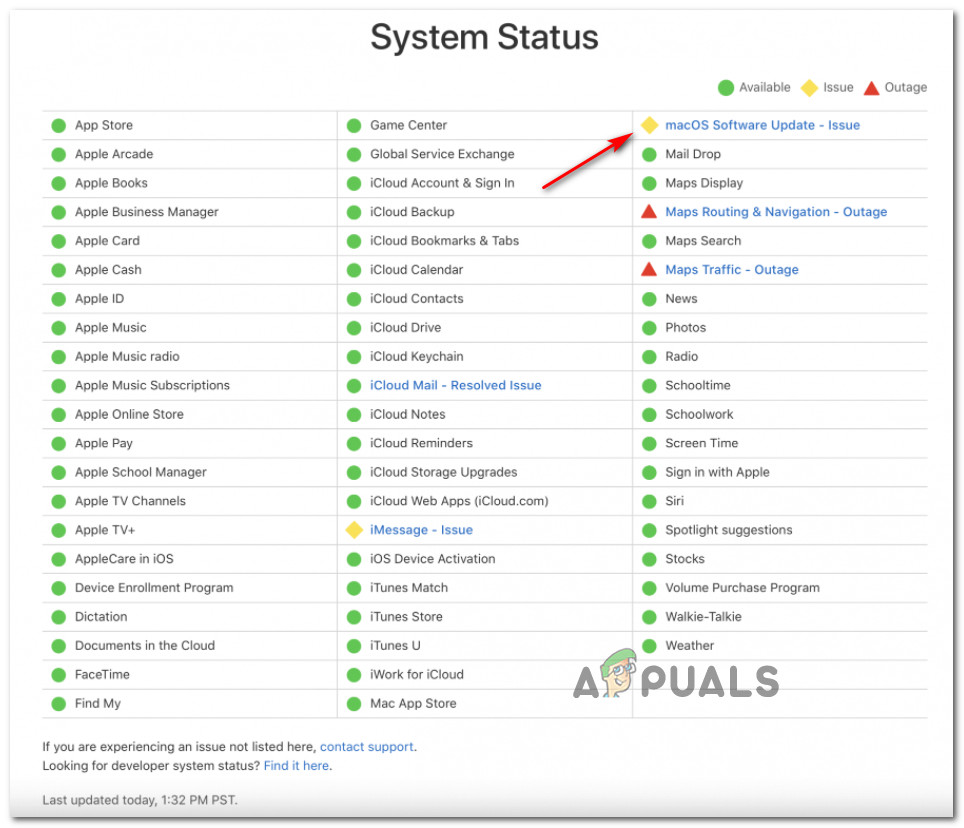
If this investigation has allowed you to discover an underlying server issue, there’s nothing you can really do to fix the problem – All you can do is wait for Apple’s engineers to resolve their server issue.
On the other hand, if the status page is reporting no underlying issues or outages with the macOS Software Update component, you can conclude the problem is not server-related – In this case, start following the next potential fixes below.
Restart or Reset your Router
If you see this error occurring every time you attempt to download the pending system update for macOS, there’s a very big chance you’re dealing with a networking glitch that has affected a lot of Mac users in the past.
In case you are dealing with this problem, you’ll end up seeing the update failed error regardless if you’re performing the update from the System Preferences tab or downloading it from the official download page.
Fortunately, the problem is most likely occurring due to a generic case of badly cached IP / TCP data that is forcing the Apple server to reject the connection due to a security concern.
If this scenario is applicable, you should be able to fix the issue by performing a router restart or reset procedure.
Note: If you can get the issue fixed with a simple router restart, do that instead of resetting your network
Restart your Router
A simple router reboot procedure will achieve the purpose of clearing the currently cached data for Internet Protocol and Transmission Control Protocol data.
To go for a router reboot on your network device, start by identifying the power button (it’s typically located on the back of the device). When you see it, press it once to cut off power.
As soon as power is cut off from the device, go ahead and disconnect the power cable from the power outlet and wait for 1 minute or more before plugging it back in in order to allow the power capacitors enough time to drain themselves.
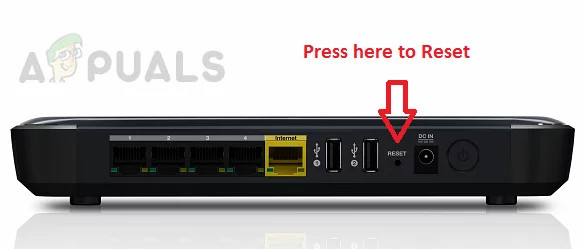
Once the time period has passed, start your router once again, attempt to install the same update that was previously failing with the ‘An error occurred while downloading the updates (Update Failed)’ error prompt and see if the problem is now fixed.
If the problem is still not fixed, move down to the next potential fix below.
Reset your Router Configuration
If the simple router restart didn’t fix the issue for you, the next logical step is to go for a complete network device reset to ensure that no network-related setting or cached data is currently preventing your macOS system from updating itself.
Important: Prior to resetting your network device, it’s important to understand that this operation will affect your current network setup. Any forwarded ports, blocked items, and any other type of custom settings will be lost once you go through with this procedure. Even more, if you’re using PPPoE, you will need to re-do the credentials before you can restore Internet access.
If you understand the consequences, you can initiate a router reset by locating the reset button on the back of your router.
Note: Typically, this is a built-in button that can only be reached with a sharp object (needle, toothpick, etc.) in order to prevent the accidental process.
Once you manage to locate the reset button, press and hold it for 10 seconds or more or until you notice that the front LEDs all flash at the same time.
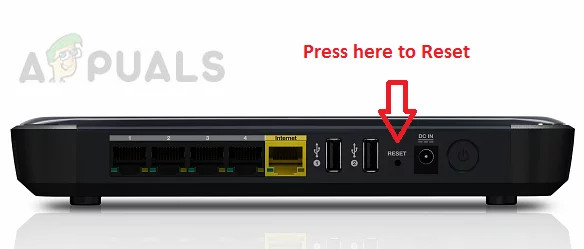
After the router is successfully reset, go ahead and re-establish the connection by re-inserting your PPPoE credentials and see if the problem is now fixed.
If you’re still unable to complete the update on your macOS, move down to the next potential fix below.
Get rid of Kernel Extension Software (if applicable)
If you’re seeing the ‘An error occurred while downloading the updates (Update Failed)’ while attempting to install the Big Sur update, one fairly common culprit is 3rd party software that works by installing kernel extensions.
Common culprits in this particular case are software like Parallels, CPU Gadget, and Little Snitch.
If any of the 3rd party software mentioned above is currently installed on your Mac (or a similar tool), the only thing you have to do to bypass the error is to temporarily uninstall them from your macOS in order to ensure that the Big Sur update can be installed with no roadblocks.
If you’re looking for specific instructions on how to do this, follow the steps below:
- Open the Finder app from the Launchbar at the bottom of the screen.

Open the Finder app - Once you’re inside the Finder app, access the Applications tab and locate the kernel extension software that you suspect might be conflicting with the Big Sur update.
- After you locate the problematic software, right-click on it and choose Move to Trash (Move to Bin) from the context menu that just appeared.
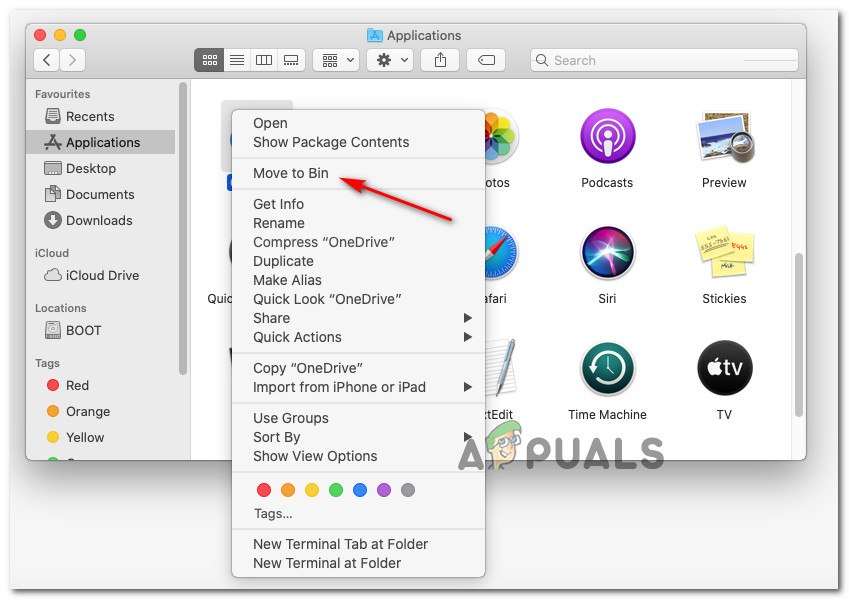
Uninstalling the problematic macOS application - If you get asked to insert your username and password, do so in order to grant the necessary permissions to uninstall the application.
- Once the uninstallation procedure is complete, reboot your macOS device and wait for the next startup to complete before attempting to install the Big Sur update once again.
If the problem is still not fixed, move down to the next method below.
Reset PRAM & NVRAM Caches
If none of the other fixes above have worked in your case, it’s very likely that you’re dealing with an NVRAM (Non-Volatile Random-Access Memory) or PRAM (Parameter Random-Access Memory) issue that is preventing your system from properly dealing with temporary files.
Info: macOS computers will use NVRAM to store certain settings data that can be accessed quickly, while PRAM is used to store information related to some core components of your MAC.
If you’re indeed dealing with an issue cause by either of these caches (NVRAM or PRAM), you should be able to fix the problem by resetting both the PRAM and NVRAM caches.
If you’re looking for specific step by step instructions on doing this, here’s what you need to do:
- Start by shutting down your MAC conventionally (regular shut down, not hibernation mode).
- After you made sure that your Mac is turned off completely, turn it ON and immediately press and hold on the following keys:
Option + Command + P key + R key
- Keep all keys pressed for over 20 seconds or more.
- When your macOS gives the impression that it’s preparing to restart, DON’T let go of the four keys yet.

Resetting the NVRAM and PRAM caches on macOS - Next, listen for the 2 startup tones. Once you hear the second beep, release all keys at once.
Note: If you’re using a Mac with T2 Security chip implementation, you’ll need to be releasing all 4 keys after the Apple logo disappears for the second time. - Once the next startup is complete, attempt to install the pending update once again and see if the problem is now fixed.
If the problem is still not fixed, move down to the next potential fix below
Remove iTunes entries from the /hosts File
According to some affected users, you can expect to see this particular error code due to a bad /etc/hosts file that is interfering with the updating process.
Most likely, the problematic key that is effectively blocking the update to the Big Sur iteration is 127.0.0.1 osxapps.itunes.apple.com.
Several affected users that were previously dealing with the same kind of issue have confirmed that the problem was resolved once they accessed the /hosts file and removed the problematic entries that we’re interfering within the updating process.
If you’re looking for specific instructions on accessing and modifying the hosts file on macOS, follow the instructions below:
- Use the Launchpad at the bottom of the screen to open the Finder app.

Opening the Finder app - Once you’re inside the Finder, access the Applications tab, then open the Terminal app from the list of available options.
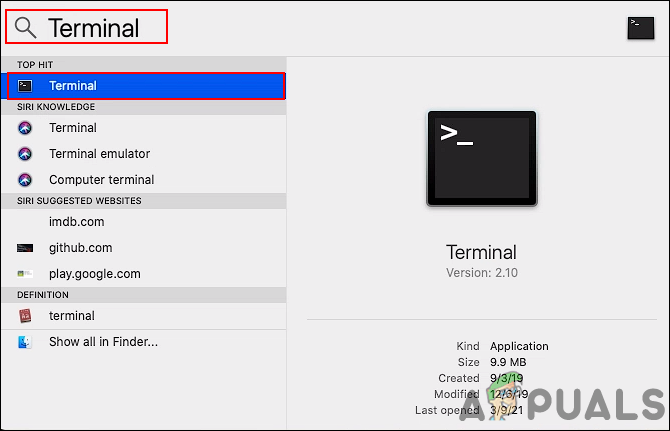
Opening the Terminal app - Once you’re inside the Terminal app, type the following command and press Return (Enter):
sudo nano /etc/hosts.
- When you’re asked to enter the password for your active user account, enter the required information so you’ll be granted access to the hosts file.
- Once the /hosts file is opened, scroll through the Hosts Database and locate the following entry:
127.0.0.1 osxapps.itunes.apple.com.
- Once you see it, simply delete the line from the hosts file to remove it completely and press Control + O to save the changes and ovveride the hosts file with this variant.
- Finally, exit the Nano Editor app and restart both your macOS and your router before attempting to install the pending update once again.
If the problem is still not fixed, move down to the next potential fix below.
Clean the Caches folder of macOS
As it turns out, this particular issue can occur due to a series of corrupted temp files that might reside in the Caches folder. Under certain circumstances, corrupted cache files can interfere with the installation of new pending system updates and cause the Update Failed error.
Several affected users that were also dealing with this problem have managed to fix it by accessing the Library folder and clean the contents of this folder.
Note: This procedure is perfectly safe and will not cause any issues with your macOS installation.
Keep in mind that in order to do that, you will need to start by accessing the System Preferences menu and disable the iCloud integration with Calendar in order to be able to remove the files from the Caches folder.
Important: If you want to ensure that you don’t end up doing any collateral damage, we recommend that you start by doing Time Machine Backup before starting with the steps below.
Once you are ready to get started, begin following the steps below:
- Use the ribbon at the top to click on the apple icon, then click on System Preferences from the list of available options.

Accessing the System Preferences screen - Inside the System preferences menu, click on the iCloud entry (left-hand section) of the screen.
- Next, from the iCloud settings, move over to the right-hand section, then uncheck the box associated with Calendars.
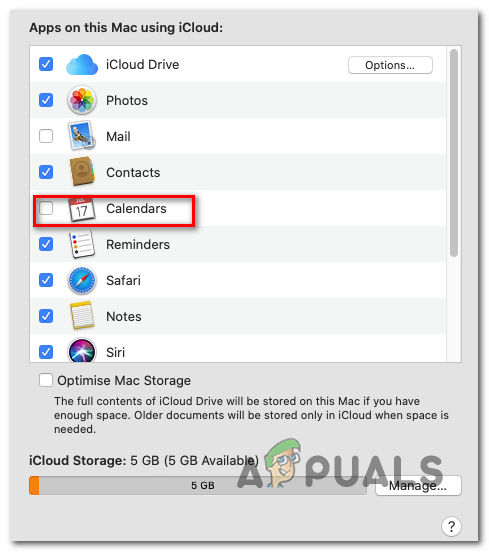
Accessing the Calendar apps - After iCloud calendar sync has been disabled, use the action bar at the bottom to click on your Finder app.
- Once you’re finally inside the Finder app, press and hold on to the Option key, then press the Go entry from the ribbon menu at the top and select Library from the list of available items.
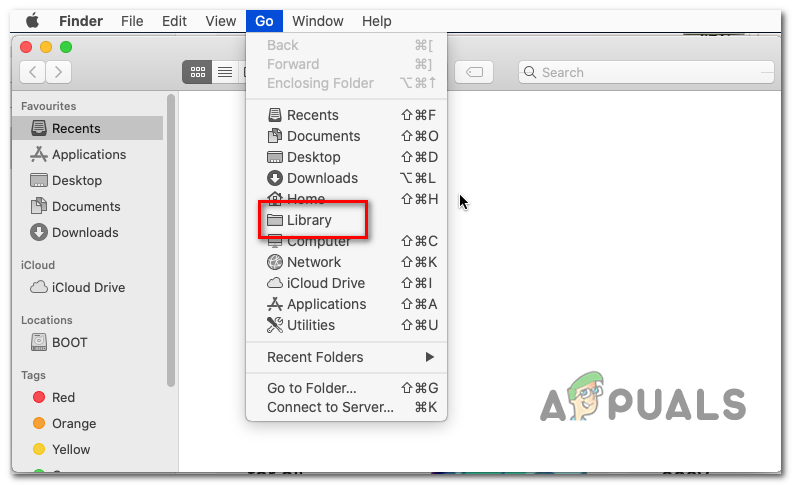
Accessing the Library folder - When you manage to arrive inside the Library folder, start by finding the Caches folder. Double-click on it to select it once you finally see it.
- Once you arrive inside the Caches folder, press CMD + A on your keyboard to select everything, then press CMD + Backspace to delete them (or right-click > Move to Bin).

Deleting everything in the caches folder Note: Keep in mind that the Cache folder will only contain temporary files that various applications installed in your macOS ecosystem use. Deleting them might prompt you to sign in again with some applications, but it won’t break any applications.
- Restart your macOS machine, then attempt to reinstall the pending System update once the next startup is complete to see if the problem is now resolved.
If the same kind of issue is still occurring, move down to the final potential fix below.
Clear the Software Update Catalog
If none of the fixes above have proven to be effective in your case, you should start considering a scenario in which there’s a glitch affecting the Software Update Catalog of your macOS computer.
Several macOS users facing the same kind of issue have confirmed that they were finally able to bypass the ‘An error occurred while downloading the updates (Update Failed)’ error by opening the Terminal app and deploying a command that cleared the Software Update Catalog.
This operation will effectively re-generate the Software catalog and eliminate any type of glitch that is currently causing the error message.
If you find yourself in this particular situation, follow the instructions below to open a Terminal app and clear the software update catalog using a sudo command:
- Start by opening the Finder app using the action bar at the bottom of the screen.
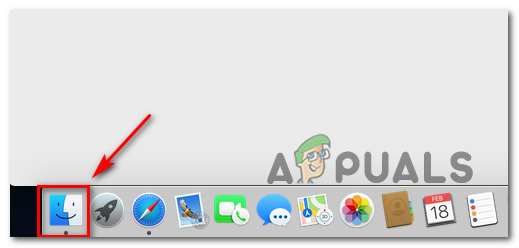
Accessing the Finder app - Once you’re inside the Finder app interface, click on the Go button (using the ribbon bar at the top), then click on Utilities from the newly appeared context menu.

Accessing the Utilities menu - Once you’re inside the Utilities screen, double-click on the Terminal app and insert your account password if asked for it.
- After you’re finally inside the Terminal app, type the following command and press Enter (Return) to effectively clear the Software Update Catalog on macOS:
sudo softwareupdate --clear-catalog
- After the command is processed successfully, reboot your Mac and attempt to install the pending system software once your computer boots back up.





